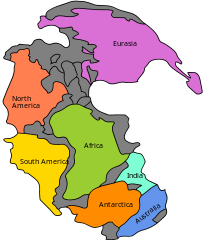Pangea
⚠️ LLM-generated content notice: Parts of this page may have been created or edited with the assistance of a large language model (LLM). The prompts that have been used might be on the page itself, the discussion page or in straight forward cases the prompt was just "Write a mediawiki page on X" with X being the page name. While the content has been reviewed it might still not be accurate or error-free.
see KG Explorer for the principle
Continental Drift Knowledge Representation Research
This page discusses different approaches to representing the evolution of continents from Pangea to present day configurations, focusing on knowledge representation methods and their comparative analysis.
Research Approach
The research combines top-down and bottom-up ontology development approaches to study continental drift representation:
Top-Down Approach Using LLMs
- Utilizing Large Language Models for concept extraction
- Developing hierarchical relationships
- Identifying temporal and spatial patterns
- Documenting reasoning processes
Bottom-Up Approach Using Wikidata
- Starting from Wikidata's Pangea node (Q4398)

- Mining related properties and relationships
- Analyzing successor landmasses
- Mapping temporal relationships
- Understanding existing classification schemes
Knowledge Representation Methods
Description Logic Approach
Example:
Landmass ⊑ GeologicalEntity hasName ⊑ DataProperty hasArea ⊑ DataProperty Landmass ⊑ ∃hasName.String ⊓ ∃hasArea.Float hasPredecessor ⊑ ObjectProperty hasSuccessor ⊑ ObjectProperty
Limitations:
- No direct support for methods/functions
- Limited attribute support
- No built-in temporal reasoning
- Complex ancestry tracking
UML Model Approach
Key Classes:
- Landmass
- GeologicalEvent
- SplitEvent
- MergeEvent
- TimeRange
- GeoCoordinate
Advantages:
- Clear representation of relationships
- Support for methods and attributes
- Easy implementation path
- Natural temporal modeling
- Straightforward data storage options
Comparative Analysis Framework
Evaluation Criteria
- Modeling Power
- Temporal representation
- Spatial relationships
- Historical uncertainty
- Causality representation
- Implementation Aspects
- Development complexity
- Query capabilities
- Performance characteristics
- Scalability
- Data integration
- Scientific Considerations
- Formal verification
- Property provability
- Scientific reproducibility
- Extensibility
Research Focus
The primary research investigates misalignments between top-down (LLM-derived) and bottom-up (Wikidata-derived) ontologies, examining:
- Structural differences
- Missing concepts
- Conflicting relationships
- Temporal representation variations
- Classification discrepancies
- Granularity differences
Implementation Approaches
Several implementation strategies could be considered:
- OWL/SPARQL endpoint
- Object-oriented application with YAML storage
- Graph database implementation
- Domain-specific language development
- Mathematical model using differential equations
- GIS-specific modeling